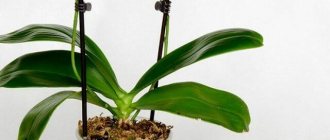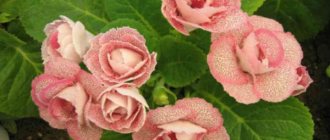When the orchid has faded, few people know what to do with the arrow. Someone removes it along with the root system, which leads to the death of the plant. Beginning flower growers are in search of the right answer, but the opinions of experts differ, so no one dares to take the necessary actions.
Due to the indecisiveness of the gardener, the situation gets out of control, as a result of which the arrow fades, or the orchid begins to bloom again. Since these actions take place already in winter, the process is not pleasing with the beauty of the colors, and subsequent restoration takes too much time.
There is a similar article on this topic - Why do orchid leaves turn yellow? Diseases and their treatment.
How to make an orchid bloom?
Problems with the completion of orchid flowering can arise quickly. As a rule, a flower is purchased in most cases during a wonderful period, when there are several lush inflorescences of a juicy shade on the arrow.
Having brought home a flowerpot with a plant, many novice gardeners discover their rapid withering: the petals fall off, and the leaves wrinkle and take on a completely unattractive appearance.
Of course, the question arises about the re-blooming of the orchid. But how to do this?
In order for the orchid to begin to bloom again, you can use some methods that, due to their specific nature, can provoke the flowering process. But before using the following methods, you need to find information about your plant variety.
It is possible that some methods cannot be used specifically for your variety. Do not destroy the plant during its growth stage.
Some gardeners prefer to use special fertilizers to make the orchid bloom. Any compositions suitable for your variety, purchased at a specialized floristry store, may be suitable here.
It should be noted that not all orchids succumb to such pressure. Find out the age of your plant. If it is relatively middle-aged, then there can be no talk of multiple annual flowering. Overfeeding will only lead to the death of the plant.
Experienced flower growers and masters of their craft know several ways to make an orchid bloom. You can use some of them.
Creating a drought
Study carefully your plant variety, namely the watering features. Now drought conditions are purposefully created for the orchid. The presented method can be used for any variety that does not require time to rest and is capable of blooming, if necessary and stimulated, for almost a whole year.
The method can be used in any season; you can use it immediately after purchase if the plant has shed all its inflorescences. If you carry out all the actions correctly, you will be able to enjoy the beauty of the purchased flower within a month.
So, do the following:
- Reduce the amount of watering. Check the soil and roots by touch. If they are dry, then we leave them like that for several days. In summer, this dry period lasts for 3–4 days; in winter or during the cool season, the soil can be left dry for a week. After time, water the plants according to the general recommendations for caring for orchids.
- If you don’t have the desire or time to check the soil for drought every time, you can use another method - simply reduce the number of waterings by half.
- During a period of peculiar drought for a plant, it cannot be sprayed, fed, or carried out other additional actions.
- After watering the plant after several days of drought, begin the next cycle. Similar actions are carried out until the orchid blooms - a peduncle should appear.
- With the appearance of the peduncle, caring for the orchid continues, taking into account all the rules and features related to the usual regime. Here you are allowed to use fertilizer, according to the instructions of the composition you purchased.
- With the beginning of flowering, watering is slightly limited, but the soil is not allowed to dry out.
- If all of the above actions are carried out in winter, then the flower must be provided with good lighting. It is enough to use additional light from a fluorescent lamp, and the light can only fall on the crown of the arrow.
If you are concerned that the use of the method does not give its results, conduct a kind of test to determine the correctness of your choice. When the process is started, the lower leaves of the orchid soften slightly, which signals the benefits of the procedure.
How to make an orchid bloom? Video:
Temperature regulation
Create comfortable conditions for the orchid, which are most often observed in regions with a temperate climate. The plant will feel better and give you beautiful inflorescences. Here it is recommended to carry out several manipulations with temperature so that a characteristic and sharp drop is observed.
Start in the following order:
- It is better to carry out the procedure in the spring, when the night temperature has already settled and is at least +16°C. Take the orchid pot out onto the balcony or veranda at night. You can simply install it on the balcony, but you will need to open the windows to provide the arrow with a cool wind.
- In the morning, bring the orchid back home and place it in its original place. Hide from the sun's rays - the plant should warm up, but not “scorch”.
- Maintain the recommended differential temperature of 4–6°C.
- Carry out the procedure every night until a peduncle forms, but be careful - do not freeze the plant at night.
As a result of such actions, photosynthesis significantly accelerates. At this time, the flower begins to accumulate carbon dioxide, which is wasted on flowering.
How to stimulate flowering at home?
Domestic phalaenopsis bloom as naturally as wild ones. But in indoor conditions it is necessary to monitor their health and development. It is very important to follow the rules of care so that the plant does not die after the first flowering. In addition, failure to comply with the regime can lead to the development of infections and the appearance of pests.
Let's look at the basic rules that will help flowering succeed.
Peace and stillness
Orchids do not like changing places. Moving to a new apartment is already a big stress for a flower, so you should put it in one place in the room and not move it at all. The fact is that these plants are sensitive to their position relative to light. Therefore, it is advisable that in a new house the pot should be positioned in relation to the sun in the same way as before the purchase. It’s even worth watering without moving the plant. Any movements can have a bad effect on future flowers.
Lighting
Roots need a lot of light, because they participate in the main process of photosynthesis. Normal daylight hours for phalaenopsis are 10–12 hours a day. Gardeners recommend using special transparent pots with smooth walls. In winter and autumn, the orchid needs ultraviolet lamps. This is especially important if the flowering period is just beginning.
But be careful. Excessive amounts of sunlight (that is, leaves exposed to direct rays for a long time) can cause burns. Do not allow the flower to overheat.
Temperature
Normally, the temperature difference should not exceed 4–6 °C; if it is sharper, the plant loses health. That is, it is desirable that the room temperature fluctuates within these limits day and night.
Average optimal temperature values for orchids:
- in summer during the day: +15…+32 °C;
- in summer at night: +9…+16 °C;
- in winter during the day: +15…+18 °C;
- winter at night: +9°…+12 °C.
Such indicators are not easy to maintain, but they are necessary for healthy flower development. In autumn and spring, the plant can be taken outside or onto a balcony: there the desired temperatures are maintained naturally. But do not forget that these flowers do not tolerate drafts, so it is better not to place them near an open window.
Air humidity
Dry air is harmful to fruit development, so it must be constantly moistened. Otherwise, the plant itself and the ripening flowers may simply wither.
Important! The optimal air humidity for an orchid is 60%.
There are several ways to increase indoor humidity. For example, just regularly spray the room with a spray bottle or place a bowl of water next to the plant. The main thing is to make sure that the orchid and its growing points do not get too much moisture.
Care and feeding
Proper care and feeding are very important for the development of flowers. It is recommended to use compounds with potassium and phosphorus as fertilizers: they stimulate flowering.
Attention! Using fertilizers with excessive amounts of nitrogen harms orchids: it reduces the likelihood of normal flowering and can lead to serious diseases.
After the flowers appear, the plant should be watered only with clean water. It is important to remember about the correct watering regime. It depends on the variety, environment, time of year, etc.
There are many ways to water:
- regular watering;
- moistening by immersion in water;
- warm shower (but you need to immediately wipe the growth points);
- water cushion.
As a rule, it is necessary to moisten after the soil has completely dried. During flowering, the watering regime should be more intense. After the plant has finished flowering, you need to reduce it by a month.
Why doesn’t the orchid bloom, what should I do?
When, from the point of view of specialists who have carefully studied the growth characteristics of your plant variety, the time for flowering has come, but it is not there, you involuntarily think about the question why the orchid does not bloom, but only leaves grow?
Here you should take a closer look at three features of plant care where novice gardeners make mistakes.
The main aspects of proper care include:
- Watering. The orchid grows in the tropics, and there, as a rule, droughts lasting at least a month are periodically observed. This argument makes you think about the advisability of regular watering of orchids, because housewives, due to ignorance, water the plant all year round as usual, although after flowering the orchids should be limited in moisture. Improper winter care will not lead to flowering in the spring, so use the above method and create a drought for your plant.
- Lighting. As mentioned above, orchids need lighting. This applies not only to the summer period, but also to the winter. It is extremely important to illuminate the leaves of the plant in winter using artificial lighting, because there is little daylight during this period - the days are shorter. And due to the prohibitions on keeping orchids on windowsills, this plant needs lighting more than ever in winter. To eliminate the problem of lack of flowering, install an additional special phytolamp. It creates suitable diffused light and does not dry out the air in the room.
- Temperature. The above method of creating a temperature difference is recommended to be used in the winter season. An orchid is a unique plant that requires a significant temperature difference. This way the plant feels at home in an area suitable for growth. In summer, it is recommended to always keep the orchid on the balcony, since at this time you can create a suitable temperature regime for active flowering. In winter, such a favorable climate is difficult to achieve, so you should at least open the windows to ventilate the room where the plant is located.
Carefully analyze your orchid care. Perhaps you really are making a mistake somewhere. Immediately apply a method to eliminate it, before the allotted time for flowering has passed.
A delay in the appearance of the peduncle will lead to flowering in winter, which can lead to more serious and dangerous mistakes in caring for the orchid. In this case, there is a high probability of destroying the plant.
Duration of rest. When do new shoots appear?
Of the large group of orchids, most go into a dormant state in winter. With the advent of warmth in the spring, they begin to actively grow the root part and awaken growth buds.
Orchid species that usually bloom in spring begin to produce a peduncle already in early March, on which the first flowers appear in May.
monopodial orchids form a young leaf mass, while symopodial orchids intensively grow new shoots.
At the end of the summer season, this shoot thickens, forming a pseudobulb. Closer to autumn, the growth and development of leaves and pseudobulbs stops, the pseudobulbs enter the “ripening” stage, and the orchid itself smoothly goes into a dormant state in order to repeat its usual cycle in the spring.
A state of dormancy when it has bloomed in winter does not mean that the orchid has suspended its life cycle. Quite diverse, complex biological and chemical processes continue to occur in it - the formation of new growth buds, flower buds, and the ripening of pseudobulbs continues.
Photo of an orchid blooming.
This period is very important for the gardener. These types of orchids require close attention to care and creation of conditions. The main steps to take care of at home in winter after flowering are:
- reducing the amount of daylight hours;
- a decrease in both day and night temperatures;
- a sharp reduction in watering.
If you do not follow these rules, then the state of dormancy is disturbed and not fully formed growth and flower buds begin to grow. The result is that the orchid will not bloom during the season.
This life cycle is characteristic of most orchids. But there are species that develop inflorescences either after the formation of leaves and pseudobulbs, or simultaneously with this process. These species include Odontoglossum major or “Oncidiums”. There are varieties that bloom and bloom in winter, such as 'Celogina cristata'.
Orchids with a weakly expressed state of dormancy or even a short one, so that it is even difficult to notice, are the most popular among flower growers.
These species include Phalaenopsis and Paphiopedilum. They can bloom continuously or occur at any time of the year.
Experienced gardeners recommend periodically giving such orchids rest. This is achieved by creating certain conditions under which the plant is artificially put into dormancy to gain strength, energy, grow leaves, etc.
Succinic acid for orchids
Often, beginning flower growers who have just purchased an orchid and have not enjoyed the flowering ask questions about what to feed the orchid to make it bloom. You can help in flowering with the help of a wide variety of fertilizers and complementary foods.
The properties of some of them are aimed specifically at stimulating flowering, by accelerating the process of filling and dissolving buds. But we should talk separately about succinic acid for orchids , whose effects can be noticed after just a few weeks.
Succinic acid has a general strengthening effect on the orchid root system and also promotes the formation of new weaves. This product is used by florists in specialized stores to speed up the growth of the plant and improve its flowering.
Flowering time can be significantly increased by treating the leaves and flowers themselves with succinic acid extract. Such actions can be attributed to a cunning marketing move, which customers are almost never aware of.
That is why you can observe such a nuisance as the rapid shedding of petals immediately after purchase - the orchid simply does not have enough of the usual nutrients. For the same reason, next year the plant may not bloom at all or may significantly reduce the number of flower stalks.
Use of succinic acid
Succinic acid is diluted according to the instructions. If you purchased the product in tablets, then one tablet should be diluted in half a liter of clean running water. If you purchase powder, for the same amount of liquid there is only a pinch of the bulk composition (on the tip of a knife).
The mixture is thoroughly shaken and the root system and leaves are treated with a regular spray bottle. Some florists direct the sprinkler at the flowers themselves - this helps improve their growth, increases the duration of flowering, and even gives a certain richness to the color of the petals.
The remaining water can be used for further watering of orchids. It should be noted that the diluted composition does not have an expiration date. However, it is better to use it in the first week after preparation.
Precautionary measures
Succinic acid is non-toxic and absolutely harmless to humans, so it can be used to treat other indoor plants that have withered and refuse to bloom again. But it should be remembered that even acid may be useless in stimulating flowering if the plant itself is already quite old. Excessive use of acid can cause the death of the plant.
Using succinic acid, video:
How to trim stems?
After flowering, the pseudobulb stems of the orchid begin to shed their leaves and completely lose their decorative effect. But you should not prune healthy bulbs, since they contain a supply of nutrients for the growth and development of the plant. Very old and dried stems can be pruned if the bush has grown excessively. For rejuvenation, it is divided into several parts.
The procedure is carried out differently depending on the type of plant:
- The dendrobium is divided into parts so that each has 4 pseudobulbs with a new shoot.
- On Cattleyas and Lelias, 3–5 pseudobulbs with living buds and shoots are left.
- In Cumbria there are 4–5 pseudobulbs on each division.
- Paphiopedilum (lady's slipper) is divided into parts with 2–3 rosettes on each.
Important! In sympodial orchids, single rosettes and pseudobulbs cannot be separated.
How to prune correctly
There are 2 ways to trim off the wilted parts of a phalenpsis:
- They get rid of the stems at the base, leaving two-centimeter stumps above the ground.
- The arrows are cut off partially above the dormant bud by 2 cm.
The orchid has faded, what to do next?
When the orchid has faded, most gardeners leave it until next year or flowering, limiting watering and care. As already described above, even during the dormant period, the presented plant should be looked after properly so as not to be sad in the spring and not take drastic measures to force the orchid to bloom.
Reduce watering, do not use fertilizing, but do not limit the flower's lighting. The plant should not be moved out of sight.
Follow all instructions for caring for your orchid, as otherwise you may cause the plant to die.
How to trim the peduncle? Video:
How to prune an orchid after flowering?
A separate point is to consider further manipulations with the orchid’s arrow. When the flower completely sheds its petals, the orchid's needle itself will begin to fade. This indicates the natural growth process of the orchid. In this case, you should not interfere. Leave everything as it is and wait for a new flowering.
Sometimes the arrow does not stop growing. It may increase in height, but flowering will not begin. Then the arrow needs to be cut. It is better to do this with ordinary scissors.
Pruning is done just above the buds by about 1.5 cm. If this distance is not maintained, the orchid may begin to bloom again.
It is recommended to cut off the arrow during dormancy, since it can absorb all the nutritional components. As a result, the orchid will not grow normally. The leaves will begin to wither, and flowering will not begin in the spring, since the root system of the plant will be very weak.
How to care for a plant after flowering
If the conditions of keeping the orchid are not violated, then after a few months the flowering ends. The process occurs smoothly: first, the flower that bloomed first fades, then the next one dries up, and so on. Sometimes it happens that all the flowers wither at the same time - this is a sign of an error in care. If an orchid has several flower stalks extending from the trunk, then flowering can be long. When the last arrow fades, the process is completed. Until this time, there is no need to rearrange or prune the plant.
Video: to cut the arrow or not?
Practice pruning at home
It must be said that manipulations with the peduncle directly depend on the type of orchid. The most common plant in our homes is phalaenopsis, so let’s start with it.
If, after the flowers have withered, the arrow begins to dry out, then it is cut as low as possible, trying to preserve the leaf. It is advisable to seal the cut of the peduncle, which is hollow inside, with beeswax or garden varnish, otherwise, when spraying, water may get into it, which will lead to rotting.
The dried peduncle of the Phalaenopsis orchid is cut off completely
Often the peduncle of phalaenopsis remains green after flowering - it is better not to touch it. After a dormant period, when the plant rests, new shoots or children will appear from dormant buds.
Green arrows Phalaenopsis should not be removed
To stimulate the appearance of new flower stalks, partial pruning is sometimes used. In this case, the arrow is shortened, leaving 3-4 dormant buds, from which new flower stalks will appear over time.
Shortening the faded shoot of phalaenopsis stimulates the appearance of new flower stalks
When trimming an orchid, it is advisable to sprinkle the sections of peduncles with crushed coal - this will protect the arrow from rotting.
Sometimes flower stalks are removed completely for purely aesthetic reasons - protruding sticks spoil the appearance of the plant. There is nothing wrong with this technique, and with proper care, in due time, the orchid will produce new arrows. The orchid is a fairly hardy plant, and pruning will not lead to its death if it received the necessary care.
Further care for the orchid
Caring for an orchid after flowering involves further transplanting it into a slightly larger pot. A wide slot should be made in the middle of the container so that water does not linger during watering and cause rotting of the roots.
Pay attention to this material - How to care for a cactus at home? Types and photos.
So, the transplant is carried out as follows:
- Moisten the soil and remove the root system. Carry out the procedure carefully. Roots that are tangled together should not be straightened - this can lead to their breakage and death of the plant.
- Inspect the root system. If you notice moss in the soil, carefully remove it. Trim off any rotten roots that have already acquired a characteristic brown tint.
- Prepare suitable soil for the orchid. It is better to use a ready-made composition or make it yourself, where pine bark, charcoal, polystyrene foam and leaf soil will be mixed. All components are taken in equal quantities, mixed and calcined to destroy pests or larvae that could be in the composition.
- Place some kind of drainage at the bottom of the pot, for example, brick chips. Install the orchid's root system and fill in the resulting soil.
After some time, the plant will take root in the new pot. All you have to do is continue to carry out your usual actions for the normal growth of the orchid. In just 2 months it will be able to bloom again.
You will be interested in this article - Spathiphyllum: care at home (flower of female happiness).
Continuation:
Take the survey!











